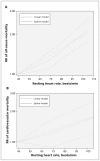Resting heart rate and all-cause and cardiovascular mortality in the general population: a meta-analysis
- PMID: 26598376
- PMCID: PMC4754196
- DOI: 10.1503/cmaj.150535
Resting heart rate and all-cause and cardiovascular mortality in the general population: a meta-analysis
Abstract
Background: Data on resting heart rate and risk of all-cause and cardiovascular mortality are inconsistent; the magnitude of associations between resting heart rate and risk of all-cause and cardiovascular mortality varies across studies. We performed a meta-analysis of prospective cohort studies to quantitatively evaluate the associations in the general population.
Methods: We searched PubMed, Embase and MEDLINE from inception to Jan. 1, 2015. We used a random-effects model to combine study-specific relative risks and 95% confidence intervals (CIs). We used restricted cubic spline functions to assess the dose-response relation.
Results: A total of 46 studies were included in the meta-analysis, involving 1 246 203 patients and 78 349 deaths for all-cause mortality, and 848 320 patients and 25 800 deaths for cardiovascular mortality. The relative risk with 10 beats/min increment of resting heart rate was 1.09 (95% CI 1.07-1.12) for all-cause mortality and 1.08 (95% CI 1.06-1.10) for cardiovascular mortality. Compared with the lowest category, patients with a resting heart rate of 60-80 beats/min had a relative risk of 1.12 (95% CI 1.07-1.17) for all-cause mortality and 1.08 (95% CI 0.99-1.17) for cardiovascular mortality, and those with a resting heart rate of greater than 80 beats/min had a relative risk of 1.45 (95% CI 1.34-1.57) for all-cause mortality and 1.33 (95% CI 1.19-1.47) for cardiovascular mortality. Overall, the results did not differ after adjustment for traditional risk factors for cardiovascular disease. Compared with 45 beats/min, the risk of all-cause mortality increased significantly with increasing resting heart rate in a linear relation, but a significantly increased risk of cardiovascular mortality was observed at 90 beats/min. Substantial heterogeneity and publication bias were detected.
Interpretation: Higher resting heart rate was independently associated with increased risks of all-cause and cardiovascular mortality. This indicates that resting heart rate is a predictor of all-cause and cardiovascular mortality in the general population.
© 2016 Canadian Medical Association or its licensors.
Figures



Comment in
-
Resting heart rate and wearable technology.CMAJ. 2016 Jul 12;188(10):755. doi: 10.1503/cmaj.1150109. CMAJ. 2016. PMID: 27402649 Free PMC article. No abstract available.
References
-
- Dobre D, Borer JS, Fox K, et al. Heart rate: a prognostic factor and therapeutic target in chronic heart failure. The distinct roles of drugs with heart rate-lowering properties. Eur J Heart Fail 2014;16:76–85. - PubMed
-
- Ohira T, Diez Roux AV, Prineas RJ, et al. Associations of psychosocial factors with heart rate and its short-term variability: multi-ethnic study of atherosclerosis. Psychosom Med 2008; 70:141–6. - PubMed
-
- Dinas PC, Koutedakis Y, Flouris AD. Effects of active and passive tobacco cigarette smoking on heart rate variability. Int J Cardiol 2013;163:109–15. - PubMed
-
- Mozaffarian D, Prineas RJ, Stein PK, et al. Dietary fish and n-3 fatty acid intake and cardiac electrocardiographic parameters in humans. J Am Coll Cardiol 2006;48:478–84. - PubMed
-
- Fox K, Borer JS, Camm AJ, et al. Resting heart rate in cardiovascular disease. J Am Coll Cardiol 2007;50:823–30. - PubMed
Publication types
MeSH terms
LinkOut - more resources
Full Text Sources
Other Literature Sources
Medical
